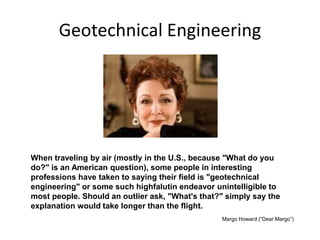Rumored Buzz on Geotheta
4 Easy Facts About Geotheta Shown
Table of ContentsGeotheta - The Facts3 Simple Techniques For GeothetaGet This Report about GeothetaMore About GeothetaSee This Report about Geotheta

They conduct site investigations, gather examples, carry out lab examinations, and assess information to evaluate the viability of the ground for construction projects - Consulting Engineers. Based on their findings, geotechnical designers supply referrals for structure layout, slope stability, retaining structures, and mitigation of geotechnical risks. They team up with various other professionals, such as designers, architectural designers, and building and construction groups, to ensure that geotechnical factors to consider are integrated into the overall task design and implementation
By evaluating the actions and residential or commercial properties of dirt and rock, they can recognize potential geotechnical dangers such as landslides, dirt settlement, or slope instability. Their expertise aids stop failures or mishaps that might threaten lives and residential property. Below are some in-depth tasks and duties of a geotechnical engineer: Site Investigation: Geotechnical designers conduct website examinations to gather data on subsurface conditions.
They interpret the data to recognize the properties and behavior of the soil and rock, including their stamina, leaks in the structure, compaction features, and groundwater problems. Geotechnical Evaluation and Layout: Geotechnical designers examine the information gathered during site investigations to evaluate the security and viability of the site for building and construction tasks. They do geotechnical calculations and modeling to review aspects such as bearing capacity, negotiation, slope stability, side earth stress, and groundwater flow.
Some Known Details About Geotheta
Foundation Style: Geotechnical engineers play a critical role in making structures that can safely sustain the desired framework. They evaluate the dirt problems and tons requirements to determine the suitable structure type, such as shallow structures (e.g., footings), deep foundations (e.g (https://www.brownbook.net/business/52934980/geotheta/)., stacks), or specialized methods like dirt enhancement. They consider factors such as settlement limitations, bearing ability, and soil-structure interaction to create optimal foundation designs
They assess construction strategies, screen website activities, and conduct field examinations to confirm that the style suggestions are adhered to. If unanticipated geotechnical issues develop, they evaluate the situation and supply suggestions for remediation or changes to the layout. Danger Analysis and Mitigation: Geotechnical engineers analyze geotechnical dangers and risks related to the project website, such as landslides, liquefaction, or soil erosion.

Cooperation and Interaction: Geotechnical engineers function carefully with various other experts included in a job, such as engineers, structural engineers, and construction groups. Effective interaction and partnership are important to integrate geotechnical factors to consider into the total job style and construction process. Geotechnical designers supply technological experience, response questions, and guarantee that geotechnical needs are satisfied.
The 2-Minute Rule for Geotheta
Here are some kinds of geotechnical designers: Foundation Engineer: Foundation engineers concentrate on making and evaluating structures for structures. They examine the dirt problems, load needs, and site qualities to figure out one of the most appropriate foundation type and style, such as superficial foundations, deep foundations, or specialized methods like heap foundations.
They examine the variables influencing slope security, such as soil buildings, groundwater problems, and slope geometry, and develop techniques to avoid incline failings and minimize risks. Earthquake Engineer: Quake engineers focus on assessing and making frameworks to hold up against seismic pressures. They analyze the seismic danger of a site, assess soil liquefaction potential, and develop seismic design requirements to guarantee the security and strength of structures during earthquakes.
They carry out area screening, accumulate examples, and examine the collected data to identify the soil residential or commercial properties, geologic formations, and groundwater problems at a site. Geotechnical Instrumentation Engineer: Geotechnical instrumentation engineers concentrate on monitoring and measuring the actions of soil, rock, and frameworks. They mount and keep instrumentation systems that keep track of factors such as dirt settlement, groundwater levels, incline motions, and architectural displacements to analyze efficiency and offer early cautions of prospective problems.
The 3-Minute Rule for Geotheta
They carry out tests such as triaxial examinations, consolidation tests, direct shear examinations, and permeability tests to collect information for geotechnical evaluation and design. Geosynthetics Engineer: Geosynthetics engineers specialize in the style and application of geosynthetic products, such as geotextiles, geogrids, and geomembranes. They utilize these materials to improve dirt security, enhance slopes, offer drain remedies, and control erosion.
They often tend to be investigatory people, which suggests they're intellectual, introspective, and analytical. They are interested, systematic, reasonable, logical, and rational. Some of them are likewise social, suggesting they're kind, charitable, browse this site participating, patient, caring, useful, compassionate, tactful, and pleasant - Engineer of Record.
In the workplace environment, geotechnical designers utilize specialized software program tools to carry out computations, produce designs, and evaluate information. They prepare records, review task requirements, interact with customers and employee, and coordinate task activities. The office setting supplies a conducive atmosphere for research, evaluation, and partnership with other professionals entailed in the project.
Geotheta Can Be Fun For Anyone
They often visit job sites to carry out site examinations, analyze geotechnical conditions, and collect data for evaluation. These brows through entail taking a trip to various locations, often in remote or challenging terrains. Geotechnical designers might carry out soil sampling, conduct examinations, and monitor building tasks to ensure that the geotechnical elements of the task are being carried out properly.
Geotechnical designers also work in specialized geotechnical labs. Geotechnical research laboratory engineers work extensively in these environments, dealing with screening tools, running tools, and videotaping information.